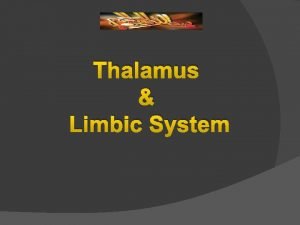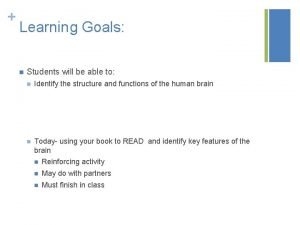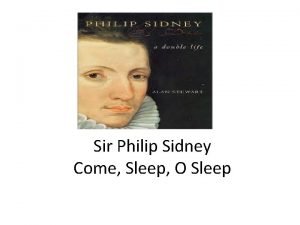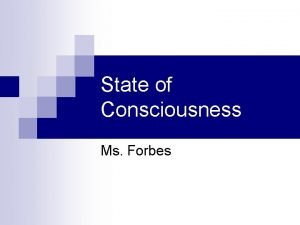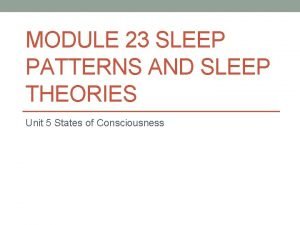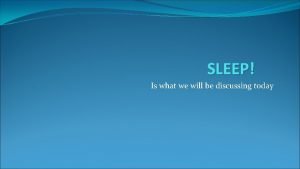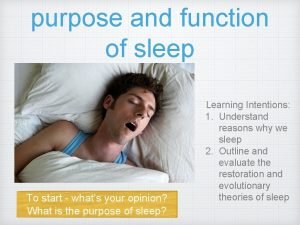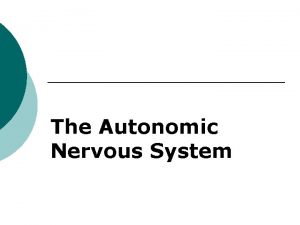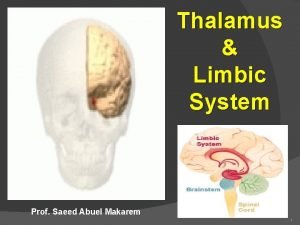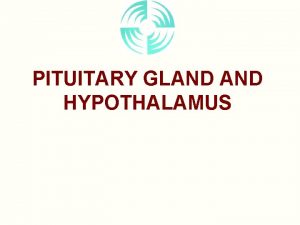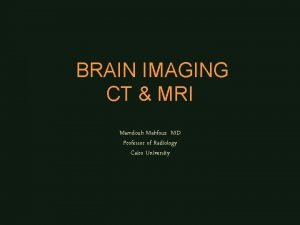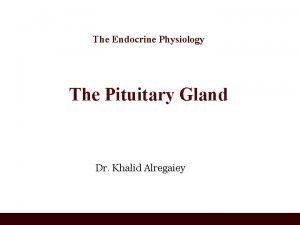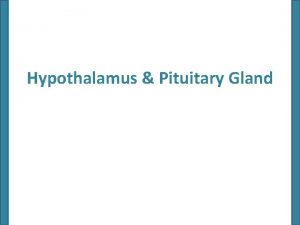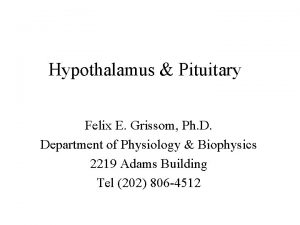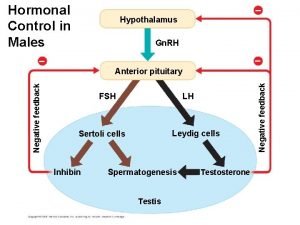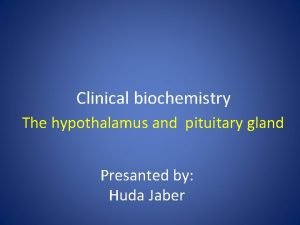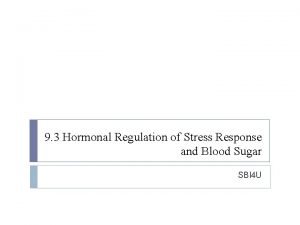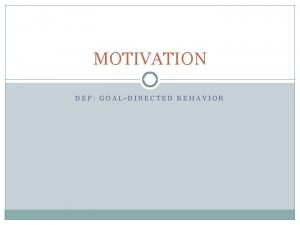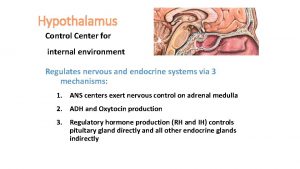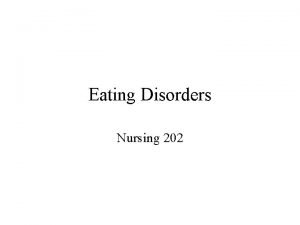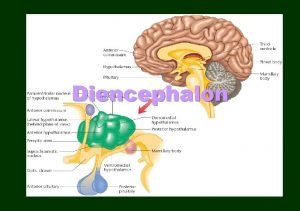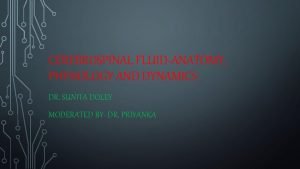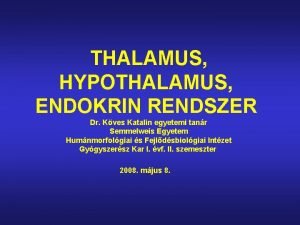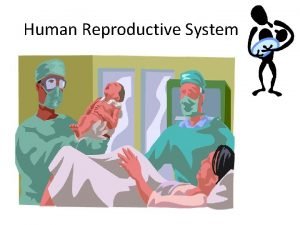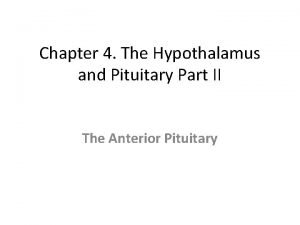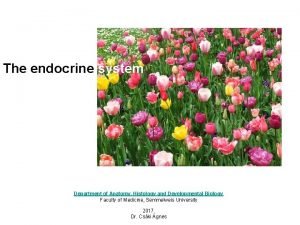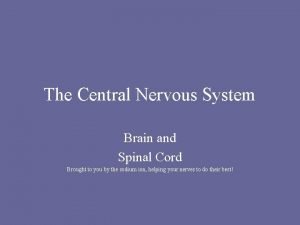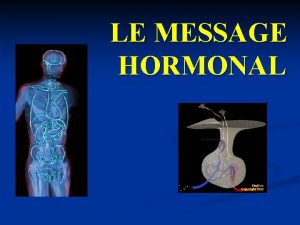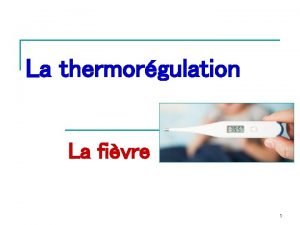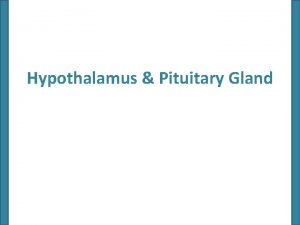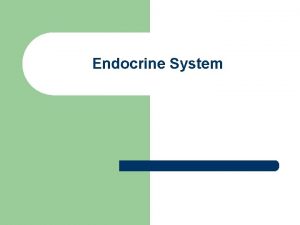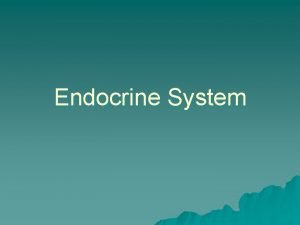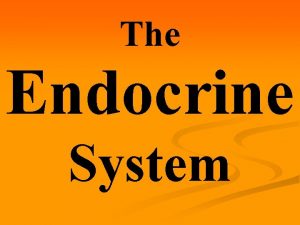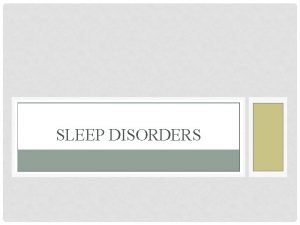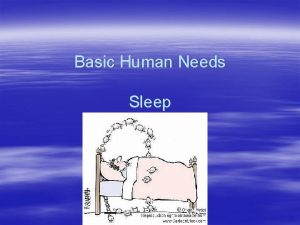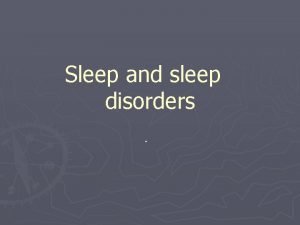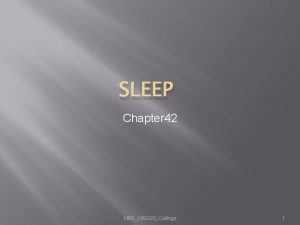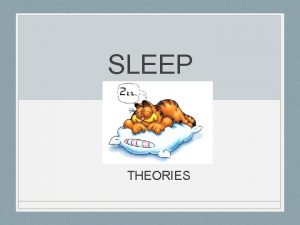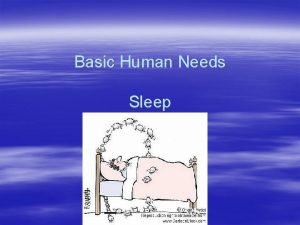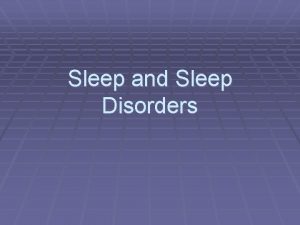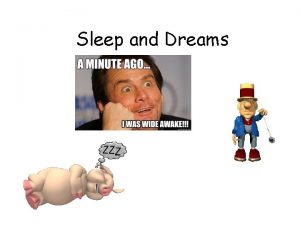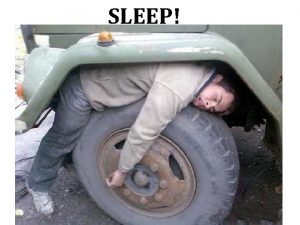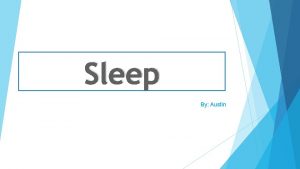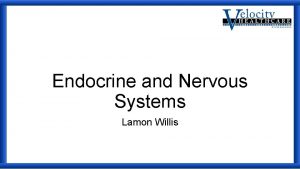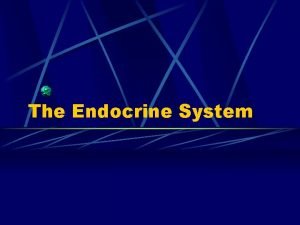The Hypothalamus Functions of hypothalamus Endocrine function Sleep









































- Slides: 41

The Hypothalamus


Functions of hypothalamus • Endocrine function • Sleep • Caloric balance • Affective behavior • Osmolarity balance • Memory • Thermal regulation • Somatic movements • Autonomic balance








Anatomy of Hypothalamus • Figure 29 -4, textbook • Anterior posterior: 4 regions – preoptic area – supraoptic region – tuberal region

Preoptic area • Medial preoptic: LHRH • Lateral preoptic: motor control

Motor connections of hypothalamus

Supraoptic region • Paraventricular: oxytocin and vasopressin (ADH) • Anterior: heat dissipation • Supraoptic: oxytocin and vasopressin Paraventricular: oxytocin and vasopressin (ADH) Anterior: heat dissipation • Suprachiasmatic: circadian rhythms Supraoptic: oxytocin and vasopressin (ADH) Suprachiasmatic: circadian rhythms

Tuberal region Dorsomedial: “sham rage” Ventromedial: satiety center Arcuate: releasing hormones and inhibiting hormones

Mammillary region • Posterior nucleus: heat conservation • Mammillary nucleus: learning and memory Posterior nucleus: heat conservation Mammillary nucleus: learning and memory

Table 30 -1 The Effect of Stimulation or Lesion of the Principal Hypothalamic Nuclei Nucleus Stimulation of Lesion of Suprachia. n. Adjusts circadian rhythms Abolishes circadian rhythms Supraoptic n. Paraventri. n. Lat. Hypotha. n. Ventromedial n. Dorsomedial n. Increased blood pressure Increased feeding Diabetes insipidus Decreased feeding Increased feeding Sham rage Mammillary body ? Decreased aggression & feeding Short-term memory is not processed Decreased feeding

Plans for Action (prefrontal cortex)

Functions of the prefrontal cortex: 1) Planning This is the area where volition, thinking ahead, problem solving are located. Before you can have these, and do them flexibly, fluently, adaptively, have to inhibit more primitive, automatic, instinctive behavior patterns; hence 2) Inhibition 3) Selectivity ‘I will do this, I will not do that’


Phineas Gage


Prefrontal Cortex Damage: • Lack of foresight • Frequent stubbornness • Inattentive and moody • Lack of ambitions, sense of responsibility, sense of propriety (rude) • Less creative and unable to plan forthe future

Sleep

Why Do We Need Sleep? Adaptive Evolutionary Function § safety § energy conservation/ efficiency Restorative Function § body rejuvenation & growth Brain Plasticity § enhances synaptic connections § memory consolidation


The ascending arousal system promotes wake A. B. Modified from Fuller et al. , J Biol Rhythms, 2006

Hypocreatin (orexin)


Sleep/Waking “Flip-Flop” vl. POA= ventrolateral preoptic area ACh = acetylcholine NE = norepinephrine 5 -HT = serotonin

Narcolepsy VS Insomnia

Melatonin: Produced by pineal gland, released at night-inhibited during the day (circadian regulation); initiates and maintain sleep; treat symptoms of jet lag and insomnia


Biological Clocks § Suprachiasmatic nucleus § A nucleus situated atop the optic chiasm responsible for organizing circadian rhythms. § Pineal gland § A gland attached to the dorsal tectum; produces melatonin and plays a role in circadian and seasonal rhythms.


SCN and sleep Wild type animal with period of ~24 h Tau mutant with period of ~20 h A SCN lesioning B Transplanting SCN of donor with ~20 -h period C SCN lesioning abolishes circadian rhythm Wild type animal acquires period of donor (~20 h) Modified from Ralph and Lehman, Trends Neuro 1991

Coffee

Coffee § During waking, brain consume ATP

Coffee § During waking, brain consume ATP § adenosine

Coffee § During waking, brain consume ATP § adenosine § Adenosine bind to A 1 receptor § Inhibit acetylcholine neurons

Coffee § During waking, brain consume ATP § adenosine § Adenosine bind to A 1 receptor § Inhibit acetylcholine neurons § Caffeine and Theophylline are A 1 antagonist
 Preoptic area hypothalamus
Preoptic area hypothalamus Thalamus
Thalamus Vmn body lift
Vmn body lift N
N Come sleep
Come sleep Adults spend about ______% of their sleep in rem sleep.
Adults spend about ______% of their sleep in rem sleep. Module 16 sleep patterns and sleep theories
Module 16 sleep patterns and sleep theories Module 23 sleep patterns and sleep theories
Module 23 sleep patterns and sleep theories Module 23 sleep patterns and sleep theories
Module 23 sleep patterns and sleep theories Mechanisms of hypothalamic control over endocrine function
Mechanisms of hypothalamic control over endocrine function Sella turcica
Sella turcica Ans
Ans Structures in limbic system
Structures in limbic system Preoptic area hypothalamus
Preoptic area hypothalamus Hypothalamus
Hypothalamus Nontropic hormones
Nontropic hormones Psychology chapter 9 motivation and emotion
Psychology chapter 9 motivation and emotion A hormone
A hormone Amegdala
Amegdala Where is trh produced
Where is trh produced Hypothalamus hormones
Hypothalamus hormones Releasing inhibiting hormones
Releasing inhibiting hormones Hypothalamus
Hypothalamus Coronal section of hypothalamus
Coronal section of hypothalamus Presanted
Presanted Parasympathetic nervous system
Parasympathetic nervous system Hypothalamus epinephrine
Hypothalamus epinephrine Hypothalamus
Hypothalamus Hypothalamus
Hypothalamus Colloid anatomy
Colloid anatomy Hypothalamus and eating disorders
Hypothalamus and eating disorders Corpus mamillare
Corpus mamillare Hypothalamus
Hypothalamus Thalamus hypothalamus
Thalamus hypothalamus Note on hypothalamus
Note on hypothalamus Structure of hypothalamus and pituitary gland
Structure of hypothalamus and pituitary gland Hypothalamus hormones
Hypothalamus hormones Janos lobe
Janos lobe Nervous sysytem
Nervous sysytem Le message hormonal
Le message hormonal Thermolyse
Thermolyse Pituitary gland
Pituitary gland

